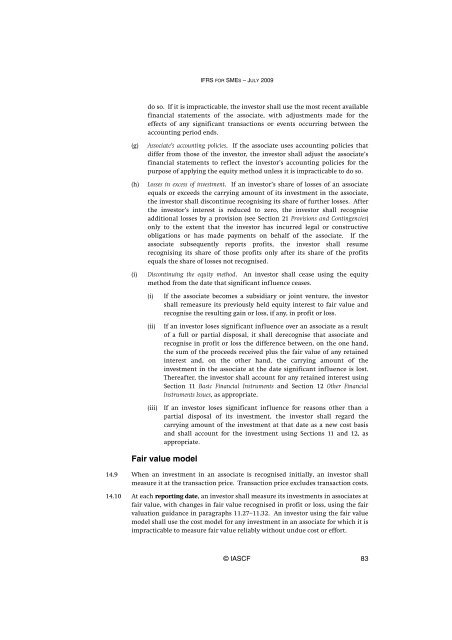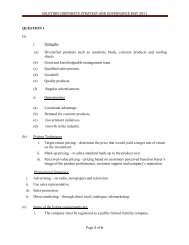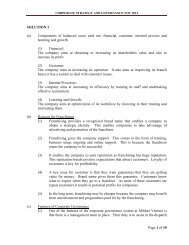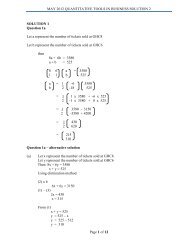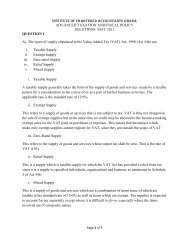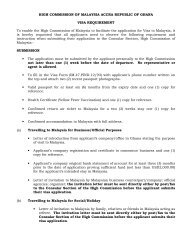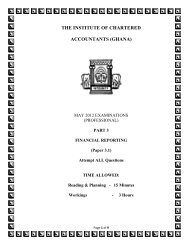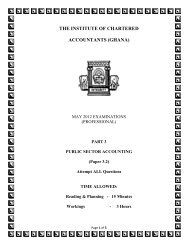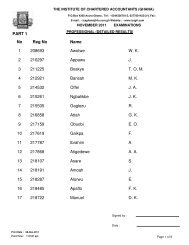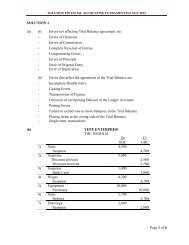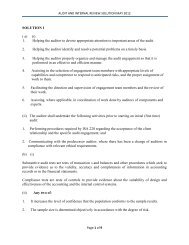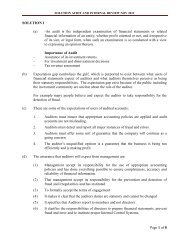(IFRS) for Small and Medium-sized Entities (SMEs)
(IFRS) for Small and Medium-sized Entities (SMEs)
(IFRS) for Small and Medium-sized Entities (SMEs)
Create successful ePaper yourself
Turn your PDF publications into a flip-book with our unique Google optimized e-Paper software.
<strong>IFRS</strong> FOR SMES – JULY 2009do so. If it is impracticable, the investor shall use the most recent availablefinancial statements of the associate, with adjustments made <strong>for</strong> theeffects of any significant transactions or events occurring between theaccounting period ends.(g)(h)(i)Associate’s accounting policies. If the associate uses accounting policies thatdiffer from those of the investor, the investor shall adjust the associate’sfinancial statements to reflect the investor’s accounting policies <strong>for</strong> thepurpose of applying the equity method unless it is impracticable to do so.Losses in excess of investment. If an investor’s share of losses of an associateequals or exceeds the carrying amount of its investment in the associate,the investor shall discontinue recognising its share of further losses. Afterthe investor’s interest is reduced to zero, the investor shall recogniseadditional losses by a provision (see Section 21 Provisions <strong>and</strong> Contingencies)only to the extent that the investor has incurred legal or constructiveobligations or has made payments on behalf of the associate. If theassociate subsequently reports profits, the investor shall resumerecognising its share of those profits only after its share of the profitsequals the share of losses not recognised.Discontinuing the equity method. An investor shall cease using the equitymethod from the date that significant influence ceases.(i)(ii)(iii)If the associate becomes a subsidiary or joint venture, the investorshall remeasure its previously held equity interest to fair value <strong>and</strong>recognise the resulting gain or loss, if any, in profit or loss.If an investor loses significant influence over an associate as a resultof a full or partial disposal, it shall derecognise that associate <strong>and</strong>recognise in profit or loss the difference between, on the one h<strong>and</strong>,the sum of the proceeds received plus the fair value of any retainedinterest <strong>and</strong>, on the other h<strong>and</strong>, the carrying amount of theinvestment in the associate at the date significant influence is lost.Thereafter, the investor shall account <strong>for</strong> any retained interest usingSection 11 Basic Financial Instruments <strong>and</strong> Section 12 Other FinancialInstruments Issues, as appropriate.If an investor loses significant influence <strong>for</strong> reasons other than apartial disposal of its investment, the investor shall regard thecarrying amount of the investment at that date as a new cost basis<strong>and</strong> shall account <strong>for</strong> the investment using Sections 11 <strong>and</strong> 12, asappropriate.Fair value model14.9 When an investment in an associate is recognised initially, an investor shallmeasure it at the transaction price. Transaction price excludes transaction costs.14.10 At each reporting date, an investor shall measure its investments in associates atfair value, with changes in fair value recognised in profit or loss, using the fairvaluation guidance in paragraphs 11.27–11.32. An investor using the fair valuemodel shall use the cost model <strong>for</strong> any investment in an associate <strong>for</strong> which it isimpracticable to measure fair value reliably without undue cost or ef<strong>for</strong>t.© IASCF 83


